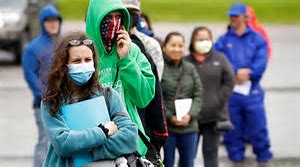US Plans School Reopening; Other Countries Begin to Reopen
As students from Vietnam have returned to the classroom, educators are now looking at plans to reopen schools around the world.
In Vietnam, students returned to their classrooms last week wearing masks. They are scanned for temperatures at the school gate. Health officials reported that the country had gone for three weeks without any new cases of COVID-19.
South Korea had been planning for high school seniors to return to classes this week and others to come back later in May.
Instead, officials have delayed the reopening after the latest coronavirus outbreak. They are now trying to identify and contact 5,500 people who had visited a popular entertainment area in Seoul over the weekend.
Both countries have contained the spread of the virus by expanding testing and tracking people who might have been in contact with anyone reported to be infected.
In the U.S., the White House released guidelines to re-open the country in three phases. It proposes that schools may reopen in "phase two," along with theaters, religious centers, sporting events and restaurants. The guidelines suggest that states could make the decision after documenting a 28-day decrease of COVID-19 cases and putting in place a strong testing program.
The Johns Hopkins Center for Health Security supports plans to re-open the U.S. in phases. The center, however, notes that there are still unanswered medical questions. One is about the rate at which children can spread the virus to others. That unknown makes it more difficult to know when schools should reopen.
The center suggests, "If schools are reopened, decisions will need to be made regarding whether tele-education will need to be provided to those students who do not come back to school, alongside in-person education being provided in school."
The American Enterprise Institute, or AEI, is a research organization that supports limited government and conservative policy. In a report for the institute, John Bailey and Frederick Hess suggest that education leaders should begin planning now to reopen in the fall based on new information about how the coronavirus disease spreads.
The two say: "Depending on the public health situation, there may be waves of stopping and starting, partial or staggered openings, or other developments."

The AEI says American leaders may learn from schools reopening in other countries. For example, Danish health officials have reopened schools but with required hand washing and social distancing rules. Spaces between students are larger and classes are much smaller. Tables, door handles and other surfaces are disinfected two times a day.
The report suggests changes to school operations including lunches and transportation.
Schools may permit only one student per seat on the school bus to observe social distancing guidelines. Large cities will need to provide a safe environment for students using crowded public transportation.
Lunches may be served in classrooms or in smaller groups. Now, some schools are bringing meals not just to students but also to people in need in the community. All of these services will add to the costs of operation and require more money.
Students will be returning to school after a long period of isolation. Some will have lost friends and family members to COVID-19. People in their family may have lost jobs. More mental health workers will be needed to help them deal with depression and anxiety.
Older teachers and staff members are at a higher risk of serious illness if they get the virus. And some may wish to continue teaching from a distance until a vaccine is available.
A small school in the western state of Montana is one of the first to reopen in this school year on May 7.
The Willow Creek School has 56 students. Bonnie Lower, head of the school system, said she knows the school is taking a risk in reopening for just two and a half weeks. But a local survey showed most of the parents in this rural community wanted to re-open the classrooms. They wanted their children to continue their studies and experience a little of normal life before the school break, she said.
To follow the CDC guideline for social distancing, Lower planned to give teachers a special tool: 1-meter-long plastic pool "noodles" to measure the distance between desks.
"It's the handiest tool on the planet right now," Lower said. "I swear we are going to live and die by the noodle."
I'm Jill Robbins.












